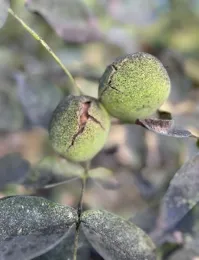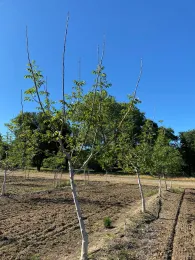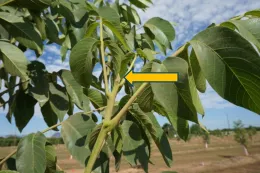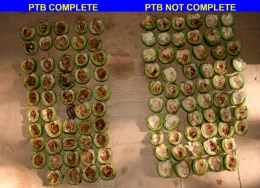Finish Walnut Season Strong for Best Crop Production
September Walnut Orchard Tasks for Agriculture To-Do List
September is the time to focus on finishing the crop season well by protecting the kernel color and quality, keeping the insect pests in check, and setting the trees up for a stress-free winter.
Irrigation and Nutrition Management in the Walnut Orchard
Avoid over-irrigating during this period as it can keep hulls green and delay drying, making the nut more susceptible to kernel mold. Prolonged humid conditions allow fungal pathogens (Alternaria, Fusarium, and Botryosphaeria) more time to enter and infest the kernels through stylar end. Using a pressure chamber to maintain trees at approximately two bars below the fully watered stem water potential (SWP) baseline could help prevent the occurrence of diseases. Baseline stem water potential (SWP) is affected by weather and relative humidity. Threading the needle with the use of a pressure chamber is also helpful at this time of year because too little water can also cost you. For example, terminating the water too early before harvest could lead to shriveling of hulls (stuck hulls) and kernels with darkened pellicles. Become an advanced pressure chamber user at: sacvalleyorchards.com/manuals/stem-water-potential/pressure-chamber-advanced-interpretation-in-walnut/. Your local farm advisor can also help you with irrigation management.
Regarding nutrition: Applications of nitrogen are wrapped up before September as kernels have finished filling and the uptake of nutrients is minimal. It is time to close out the 2025 N-budget in the Irrigation and Nitrogen Management Plan (INMP) log. Review July leaf nutrient analyses and flag the blocks which will need potassium and zinc corrections.
Major Walnut Pests to Watch For
September is a good time for pest monitoring. Trap counts should be continued for walnut husk fly, late naval organgeworm flights, and codling moth. Base treatment decisions on the observed pest activity, field conditions, and crop susceptibility.
Walnut Husk Fly (WHF): If WHF has been a previous issue in any of your orchards, keep checking the traps until early September. If not protected, later varieties such as Chandler in the cooler areas could get husk fly strikes in the late season. If trap counts indicate a late flight, apply an additional bait spray combined with an insecticide that has adulticidal activity. If insecticidal control is necessary, pay close attention to the label’s pre-harvest interval (PHI).
Codling moth (CM): In most of the walnut producing areas CM has three generations each year but in some warmer regions a partial fourth generation could occur in September. Continue monitoring traps and degree day models to determine whether a late treatment is necessary.
Navel Orangeworm (NOW): Preventing early season damage by blight, codling moth and sunburn could largely reduce NOW infestation. When husks split, monitor traps and split nuts for NOW egg laying. In late harvested varieties the third generation of NOW could infest nuts in September. If a spray is needed it should be applied as husk split begins and should be followed by prompt harvest. Of course, paying close attention to preharvest interval (PHI) restrictions. Ethephon could also be used to advance harvest to avoid NOW damage and retain light kernel color. Plan for the post-harvest removal of the mummy nuts most commonly done by shaking, blowing, and then mowing, as even a small number of infested mummy nuts can lay the groundwork for a large population in 2026.
You can learn more about these three major pests and their management at: ipm.ucanr.edu/agriculture/walnut
Molds that Impact Walnuts

Sooty mold: Dark sooty mold may appear on the walnut leaves and nuts (photo 1) from August to October. It is a fungal growth developed on the sugary honeydew secreted by aphids, scales, and mealybugs. Sooty mold does not directly infect the trees, but it may reduce photosynthesis and potentially affect nut quality. This mess is best managed by controlling insect pests. Both by maintaining beneficial insect populations by avoiding broad-spectrum materials earlier in the season and using targeted insecticides if beneficials can’t keep up. Good air circulation and avoiding over application of nitrogen can also help reduce the development of sooty mold.

Kernel mold: Have you had mold show up as defect on your grade sheets before?As mentioned above, fungal pathogens can devastate your crop quality late in the season with kernel mold.If you didn’t try the new practice of including an effective fungicide for kernel mold way back at bloom, 20-30% hull split is also an effective timing. For example, in one Chandler orchard in Butte County in 2024, a spray with Luna Experience combined with Ethephon applied at 20-30% hull split reduced moldy nuts by 54%. Mention of a fungicide is not a pesticide recommendation, just the sharing of research results. You can learn about this disease and additional effective fungicides for its management at: sacvalleyorchards.com/walnuts/walnut-mold-and-how-to-manage-it
Prepare Young Orchards for Autumn Frost
Harden off young trees. A surprise autumn frost can be devastating to young walnut orchards, setting them back a year or more. Preparing young orchards for an autumn frost begins in September with ensuring that trees have ended their growth for the year. As previously noted, the nitrogen fertilizer program for all walnut trees should be wrapped up by the end of August, however this is particularly critical for hardening off young trees. To reduce the possibility of autumn frost damage, aim to cut off irrigation for young trees by mid-September to reduce growth and harden off the trees. Look to hold off on irrigation until a terminal vegetative bud has formed on the trunk (Photo 3). Once you see that terminal buds have formed you can resume irrigation without the fear of pushing new tender frost prone foliage.

Preparing for Harvest
If you plan to use ethephon for early harvest, start weekly sampling for 100 % packing tissue brown (PTB, see photo 4) about 35 days before the normal expected harvest date. Collect around 100 nuts and cut them to make sure they have achieved 100% PTB. Avoid spraying too early as it may cause loss in yield, poor quality, and stick tight hulls.
Spray timing of ethephon is critical for different harvest goals. If early harvest is desired to protect kernel quality or spread harvest timing across your ranch to ease harvest logistics, apply ethephon as soon as all nuts reach 100% PTB. This can advance the harvest by 7-10 days, followed by a second shake about two weeks later. Alternatively, if your goal is instead a normal harvest timing but maximum nut removal to achieve a single harvest, applying ethephon as early as 5-7 days after 100% PTB can improve the nut removal percentage for a single harvest. However, the best timing to apply ethephon for a single harvest, if your operation’s logistics allow, is about 10 days before the normal harvest date. Ethephon should be applied in the evenings or early mornings as high humidity, and cool period improves the application efficacy.
It is time to mow/level the orchard floor and repair the potholes for harvesting. Blow off any early drops as they have dark pellicles and paper light kernels which could drag down your crop quality. It is important to harvest promptly when more than 95% of the nuts are hullable. To achieve the highest priced light-colored kernels, pick up nuts as soon as possible after shaking, and promptly deliver them to the huller/dryer to minimize quality losses. Most of the loss in quality occurs within first 9 hours after the harvest. Plan it for the cool part of the day, as kernels will darken faster with higher temperatures.
NOW vs CM: A Particular Problem for Walnut

Collecting a Harvest Sample: Processor grade sheets are often not very detailed and may not tell you the whole story of what problems afflicted your crop. This is a particular problem for walnut because your grade sheet may only note “worm damage” and not tell you NOW versus CM. This can be remedied by collecting your own sample of 100+ nuts from each block immediately after shaking for freezing and later examining for worm damage, mold, shrivel etc. This helps evaluate the effectiveness of your IPM program and refine your practices for next season. Guide to performing this sampling and later evaluation at: sacvalleyorchards.com/walnuts/insects-mites-walnuts/harvest-damage-evaluation-for-walnuts
